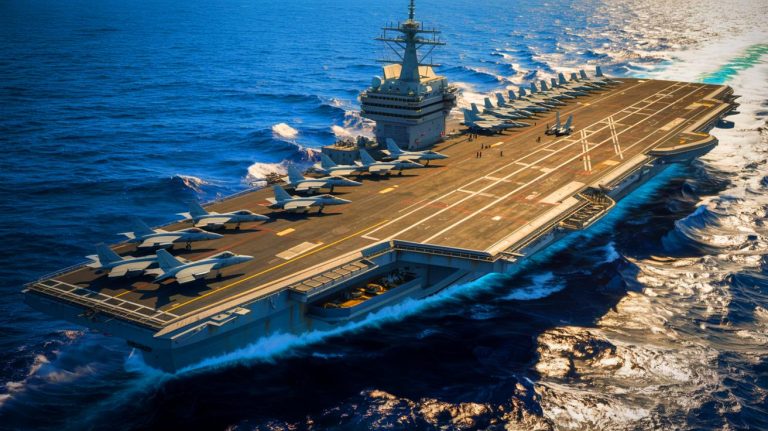| IN A NUTSHELL |
|
The USS Gerald R. Ford, the pinnacle of modern naval engineering, stands as the world’s largest and most technologically advanced aircraft carrier. Named after the 38th President of the United States, this formidable vessel represents the forefront of the U.S. Navy’s strategic capabilities. Since its commissioning in 2017, the carrier has become a cornerstone of naval operations, significantly influencing global maritime strategy. With substantial investments in cutting-edge technology, the USS Gerald R. Ford continues to set the standard for future naval warfare despite facing challenges during its development and deployment.
The Technological Marvel of USS Gerald R. Ford
The USS Gerald R. Ford is not just the largest warship globally but also a showcase of technological prowess. Measuring approximately 1,106 feet in length, the carrier features a flight deck spanning 256 feet. With a displacement of 100,000 tons, it is powered by two nuclear reactors driving four shafts, allowing it to exceed speeds of 30 knots. This capability ensures that the carrier can operate efficiently across vast distances, projecting U.S. power globally.
A key technological advancement within the carrier is the Electromagnetic Aircraft Launch System (EMALS), which replaces the traditional steam-powered catapults. EMALS increases sortie rates to 160 per day and reduces stress on aircraft, enhancing operational efficiency. Additionally, advanced arresting gear improves recovery operations, while modern weapons elevators ensure the quick and efficient transport of ordnance to the flight deck.
The power generation capacity of the USS Gerald R. Ford is equally impressive, producing three times the electrical power of its predecessors, the Nimitz-Class carriers. This capacity supports a range of sophisticated onboard systems, including advanced radar and defense systems like the SLQ-32(V)6 electronic warfare system and the Evolved Sea Sparrow Missile (ESSM) Block 1.
Strategic Importance and Global Impact
The USS Gerald R. Ford is central to U.S. naval strategy, serving as the flagship of the Carrier Strike Group. This powerful group typically includes cruisers, destroyers, and supply ships, creating a formidable force capable of sustained operations at sea. It supports air wing missions for combat, reconnaissance, and deterrence, reinforcing the U.S. military presence worldwide.
The carrier’s deployments to strategic locations such as the Mediterranean underscore its role in regional deterrence and influence. Its presence in these areas serves as a deterrent to potential adversaries, emphasizing the U.S.’s commitment to maintaining global stability and peace. Additionally, its participation in naval exercises demonstrates its capabilities and reinforces alliances with other nations.
Beyond military operations, the USS Gerald R. Ford symbolizes technological prowess and national pride. As the most expensive warship ever constructed, with a price tag of approximately $13.3 billion, it represents an investment in the future of naval warfare and security, embodying American innovation and engineering excellence.
Challenges and Controversies
Despite its impressive capabilities, the development of the USS Gerald R. Ford faced numerous challenges. The carrier’s construction experienced delays and budget overruns, primarily due to the integration of new technologies. Issues with the certification of weapon elevators, EMALS, jet blast deflectors, and radar systems contributed to these setbacks.
These challenges highlight the complexities of pioneering new technologies on such a large scale. The cost overruns, which exceeded initial estimates by 30%, have sparked debates over defense spending and the prioritization of military projects. Critics argue that the resources could have been directed toward other defense needs or social programs.
Furthermore, the ship’s automation systems, designed to reduce the crew size by 700, have prompted discussions about personnel impacts and the future of naval employment. While automation reduces operational costs and improves crew quality of life, it raises questions about job security and the human element in military operations.
Future Prospects and Adaptability
The USS Gerald R. Ford was designed with adaptability in mind. Its advanced systems allow for the integration of emerging technologies, such as advanced drones, ensuring its continued relevance in naval warfare. As threats and technologies evolve, the carrier can be upgraded to maintain its strategic edge.
This adaptability is crucial for addressing emerging challenges and maintaining the U.S. Navy’s superiority. The ability to incorporate new technologies ensures that the USS Gerald R. Ford remains a vital asset for decades to come, capable of responding to unforeseen threats and opportunities.
As the flagship of the Ford-class carriers, it sets the standard for future vessels and influences the design and development of subsequent ships. The lessons learned from its construction and deployment will inform future projects, shaping the future of naval engineering and strategy.
The USS Gerald R. Ford embodies the intersection of tradition and innovation, serving as a testament to the enduring strength of the U.S. Navy. As it continues to sail the world’s oceans, the question remains: how will emerging technologies and geopolitical shifts influence the future role of such monumental vessels in global security?








Wow, 100-foot cannons? Just imagine the fireworks on the 4th of July! 🎆
Is it really necessary to have such a large warship? 🤔
How do they even get this thing into the water without flooding the planet?
Thanks for the detailed article! It’s fascinating to see how far naval technology has come.
It’s interesting to see how automation is changing naval employment.
Imagine the level of coordination needed to operate this behemoth!
100-foot cannons? Sounds like something out of a sci-fi movie! 🚀
The cost overruns are concerning. Could the budget have been used more wisely?
Does it have WiFi? Asking for a friend.
The ship’s adaptability for future tech is a smart move.
Why not invest in peace instead of more weapons?
How does the USS Gerald R. Ford compare to other countries’ carriers?
Impressive power output! But is it environmentally friendly?
Can the USS Gerald R. Ford withstand a direct missile hit?
It’s a marvel of engineering, but at what cost to taxpayers?
Are there any plans to use this ship for humanitarian missions?
The Electromagnetic Aircraft Launch System is a game-changer! ⚡
Hope they have a good coffee machine onboard. Sailors need their caffeine!
Do they really think this will deter modern threats?
What’s next, a battleship with a Starbucks? ☕
How does this ship support the U.S.’s international alliances?
The article raises important questions about future naval strategy.
I’m curious about the living conditions for the crew on such a large vessel.
So much money, but will it actually defend us better?
Does it come with a pool? 🏊
Why do we always focus on military might instead of diplomacy?
Can this ship actually defend against modern threats like cyber attacks?
It’s a bit scary to think about the firepower this ship carries.
How does the USS Gerald R. Ford handle in bad weather? 🌊
Thank you for the insightful article on such a complex topic.
The challenges faced during its development are a real eye-opener.
Will this carrier be a part of international peacekeeping efforts?
Is there a way to tour the USS Gerald R. Ford? I’d love to see it up close!
The global debate over military power is more relevant than ever.
On a scale of 1 to 10, how “monster” are these guns anyway?
I’m skeptical about the need for such large military expenditures.
So, when do they plan to install laser cannons? 😄
What happens if one of those electromagnetic launch systems malfunctions?